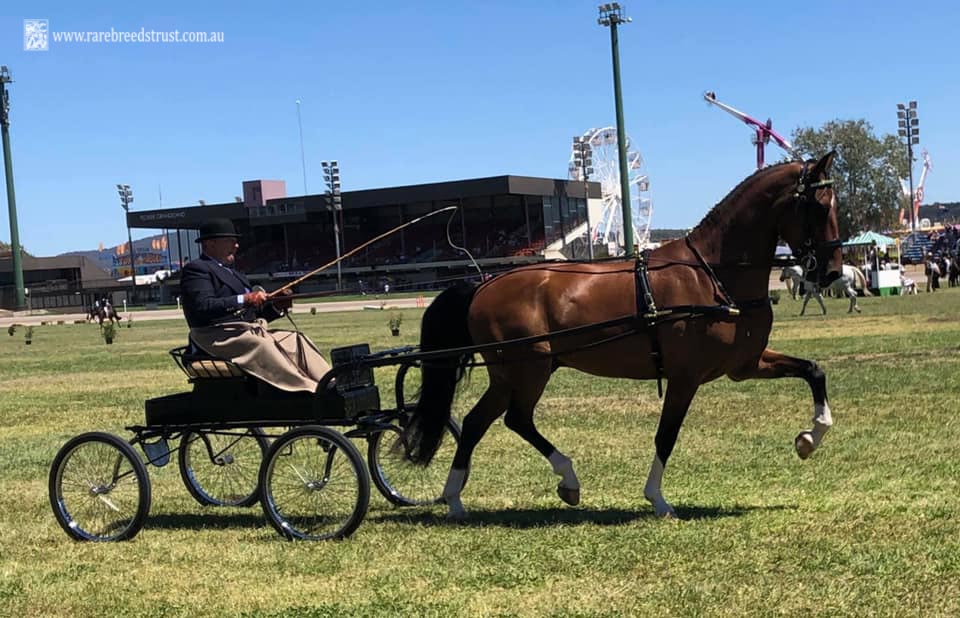
RARE BREEDS TRUST OF AUSTRALIA
powered by TidyHQHorses : HACKNEY
Horses : HACKNEY
Country of Origin
England
Australian Status

International Status
In its home country they are listed together with the Hackney Pony as Critical (Fewer than 300) and as Critical/Nearly extinct globally by the Equus Survival Trust.
Uses
Driving, hacking, jumping
Breed traits
Distinguished by extravagant high action. A showy breed associated with driving, also good for riding. Height - ponies to 14hh, horses over 14hh. Colours are bay, brown, black and less commonly, chestnut. White markings are plentiful. Upright neck carriage. Straight nose. Tail carried high. Trademark high action, forearms often above the horizontal.
History
Developed from the roadsters also called trotters, of Britain, notably the Norfolk trotter. The Norfolk traced to Old Shales foaled 1755, he to the Darley. As roads and driving vehicles improved over the nineteenth century so did horse breeds. It was the height of fashion to have a showy carriage horse, preferably several. These horses had iron feet and legs, great stamina and speed at the trot. By the twentieth century, the action was becoming higher and higher, hence slower, as city driving and finally showing took over as the main use of the Hackney. Thousands were used for cab horses.
History in Australia
In the nineteenth century, an "excellent hackney" was advertised in Hobart in 1824. Horse repositories throughout Australia regularly sold hackneys. By the 1840s in Australia, the legal term for vehicles hired with driver (cabs) was 'Hackney carriage" and "Hackney coach." By the late nineteenth and early twentieth century, many registered Hackneys were imported as their popularity hit a high. Mr W. I. Winter-Irving imported a stud of Hackneys in 1898 and exhibited some at Melbourne Royal, where they were put in the Roadster class. A news article at the time (Leader, Melb.) explained how Australia was just learning to use the term Hackney for the breed rather than call them Roadsters. The build of a trotter is ideal for jumpers too. Philip Charley among others imported several good Hackney stallions in the early twentieth century, from England and Scotland. In the current era, there are also imports from England.
Historical Australian Terms for the Hackney
In Australia, the showy action was called nail driving, as it seemed to go up and down in one spot rather than the older style of roadster-trotter bred more for speed, and it was not until the early twentieth century the showy action was sought rather than bypassed for a horse that was faster. Ponies for trotting were also developed. Trotters were also called Roadsters in Australia; the term became Hackney-roadster, then Hackney once formalised as a studbook breed. Many were called Hackney cobs, showing the build was significantly more powerful in those days. In England, it was more clear-cut as the Hackney was called by its name for longer.
Breed Organisation
Hackney horses and ponies are registered under the same umbrella
- Australia: Australian Pony Stud Book
- England: Hackney Horse Society founded in 1883.
Previous Census Data - 2020
27 mares of breeding age, with a possible 26 over 20. 13 stallions and 22 geldings.
Foal chart for the past decade
Photo Credit
Top: Hackney Horse mare Beauwood Fairy Tale, Illawarra N.S.W., taken by Leah Montefior.
Bottom: Makari Regis at Canberra Royal Show by Leah Montefiore.
Page by Janet Lane
(population updated 13/05/2020 by A.Y.)
